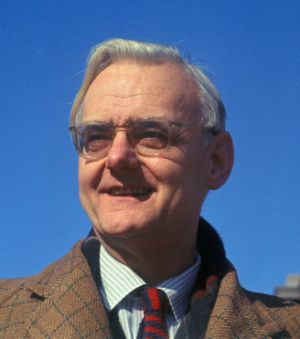Humphry Osmond
Humphry Fortescue Osmond (born July 1, 1917 in Surrey, England; died February 6, 2004 in Appleton, Wisconsin) was a psychiatrist who pioneered studies in the neurochemical causes of schizophrenia. Like Timothy Leary, Osmond spend a large part of his career researching hallucinogenic drugs. He coined the word psychedelic to describe them.
Biography
Early in life, Osmond planned to become a banker, but after graduating Haileybury School in Hertford, he found himself enrolled at Guy's Hospital Medical School at the University of London. He trained in the specialty of psychiatry while serving as a surgeon-lieutenant in the Royal Navy during World War II. Posted to St George's Hospital in London, he and John R. Smythies researched a theory that schizophrenia was caused by production of LSD-like compounds inside the brain. The discovery that brain chemistry could cause schizophrenia overturned the formerly prevalent notion that it was caused by childhood emotional trauma.
The colleagues took their research to Saskatchewan Hospital in Canada after the war. They promoted the idea that using mescaline could induce short-term schizophrenia that would help doctors to understand patients' conditions and better equip them to treat the chronic disease. One of the participants in Osmond and Smythies studies was novelist Aldous Huxley. Huxley documented his experiences with mescaline in his 1954 book The Doors of Perception.
Although Osmond had used the term "psychedelic" to describe hallucinogens in technical reports beginning in 19571., it was through his correspondence with Huxley that the term reached the general public.
Osmond's next research program involved experimenting with using LSD to treat alcoholism. Along with Abram Hoffer, Osmond administered the drug to long-time members of Alcoholics Anonymous who had been unable to stop drinking. A year after the experiment, half of the subjects had not had a drink. No other study has come close to that rate of success. AA's founder, Bill Wilson, took LSD himself and was optimistic about the drug's use.
Osmond left Saskatchewan to direct the Bureau of Research in Neurology and Psychiatry at the New Jersey Psychiatric Institute in Princeton, New Jersey. From there he became a professor of psychology at the University of Alabama School of Medicine, practicing at Bryce State Mental Hospital in Tuscaloosa. He renewed his collaboration with Smythies, who taught at the Birmingham campus of the school. After research using hallucinogenic drugs was outlawed, Osmond became interested in large doses of vitamins in psychiatric treatment. After the University of Alabama at Birmingham was founded, Glenn Ireland and his wife Mallie suggested that he accept one of the professorships endowed by them.
He later became a psychology professor at UAB, with a research focus on schizophrenia. He did not pursue research into hallucinogens after they were made illegal.
Osmond retired to Wisconsin. He died at the age of 86 from cardiac arrhythmia. He was survived by his wife, Jane; three children, Euphemia, Helen, and Julian; and five grandchildren.
Notes
- "I have tried to find an appropriate name for the agents under discussion: a name that will include the concepts of enriching the mind and enlarging the vision.... My choice, because it is clear, euphonious, and uncontaminated by other associations, is psychedelic, mind manifesting." (Osmond - 1957)
References
- Martin, Douglas (February 22, 2004) "Humphrey Osmond, 86, Who Sought Medicinal Value in Psychedelic Drugs, Dies." The New York Times.
- Smith, Anita (Fall 2004) "Pathfinder: Humphry F. Osmond, M.D." Alabama Medical Alumni Bulletin. Vol. 30, No. 3, p. 22
- Osmond, Humphry (March 14, 1957) "A Review of the Clinical Effects of Psychotomimetic Agents." Annals of the New York Academy of Sciences.
